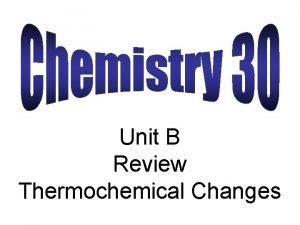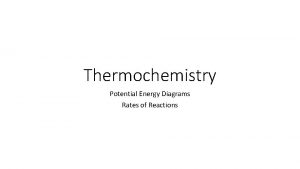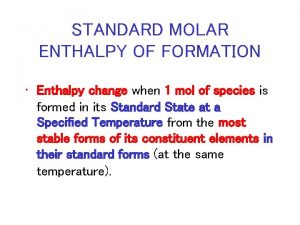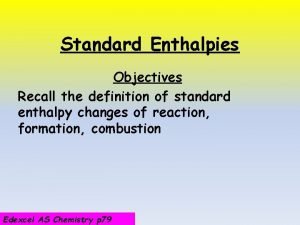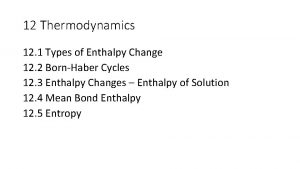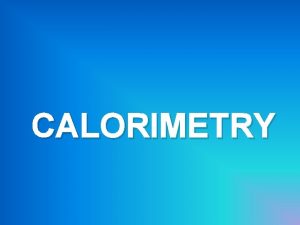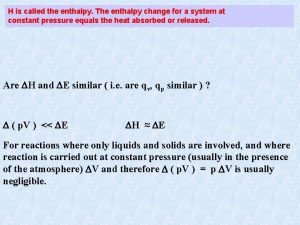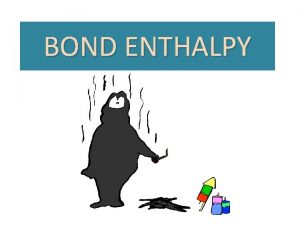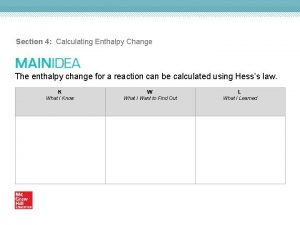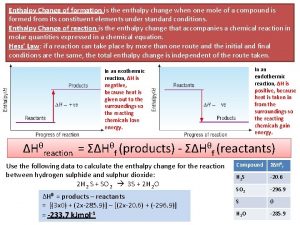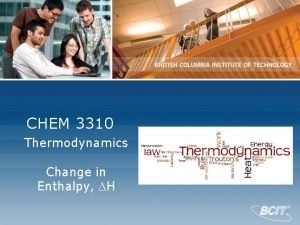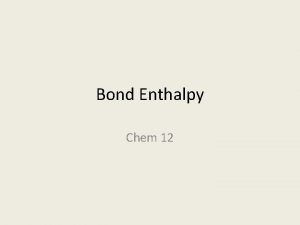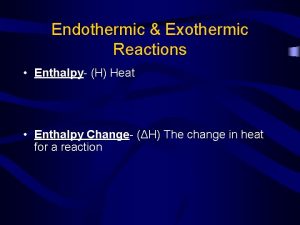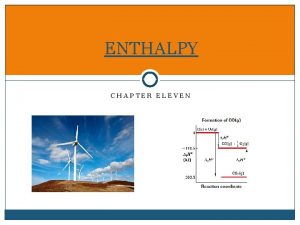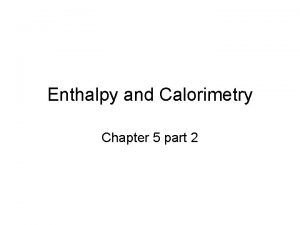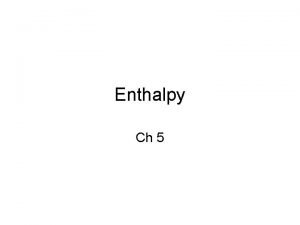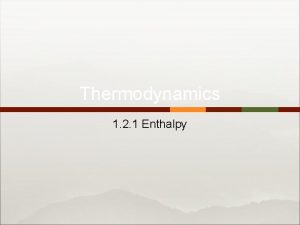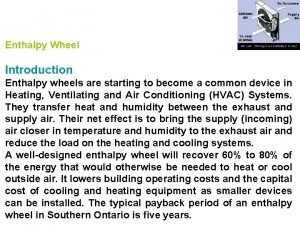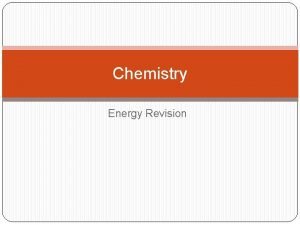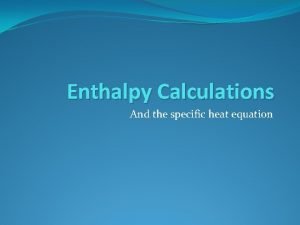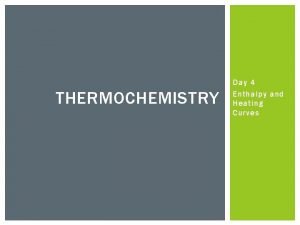ENTHALPY CHANGE CHAPTER 4 ENTHALPY Is the total







































- Slides: 39

ENTHALPY CHANGE CHAPTER 4

ENTHALPY • Is the total energy of a system. Please write • Ek= Kinetic energy. • EP= Potential energy • Vibrational • Attractive force b/w nucleons & electrons E due to • E stored by the bonds between atoms & • Rotational motion molecules. • Translational • ∆H is the change in total energy of the system during a rxn or phase change. • Most of the E exchanged is in the form of heat! • Therefore we use the change in heat as a indicator of the change in enthalpy expressed per mol!

Please sketch ∆H – PHASE CHANGES Change in Energy Ep breaks intermolecul ar bonds Energy increases the speed of molecules Change in Ek

Please write HOW TO CALCULATE ∆H MELTING ICE VAPOUR Qice = mc∆T (c=2. 05 J/g℃) + At the melting point ∆H = 6. 01 k. J/mol until all the ice is melted! + Qwater = mc∆T (c=4. 19 J/g℃) + At the boiling point ∆H = 40. 66 k. J/mol until all the water is vaporised! + Q = mc∆T (c=1. 41 J/g℃)

Please sketch lim ati on tio sa Solid Su b So lid Co nd en Exothermic Process ion at riz d n po ui tio Va Liq sa en nd Co n Gas Terminology for phase changes Melting (fusion) Freezing (solidification) Endothermic Process Liquid

observe HEAT CURVE OF A PURE SUBSTANCE t oin P g ga s n ili Bo liquid & gas Temperature (°C) ΔT(l) ui d ng i t l Me int Po liq 150 140 130 120 110 100 90 80 70 60 50 40 30 20 10 0 -10 -20 -30 -40 -50 id solid & liquid ΔH(l) sol ΔHfus 200 300 400 500 ΔHvap Heat of vaporization Heat of fusion 100 Specific heat capacity of the liquid can be determined from the inverse slope of the curve 600 700 800 900 1000 1100 1200 1300 1400 1500 1600 Energy absorbed by substance (joules / gram)

observe EVERSING A HEAT CURVE If instead we cool a hot gaseous substance…. boiling point condensation point. ion ga 150 140 130 120 110 100 90 80 70 60 50 40 30 20 10 0 -10 -20 -30 -40 -50 s t nsa e t nd Co poin heat of vaporization --> heat of condensation. liquid & gas d ui liq Temperature (°C) melting point freezing point. g zin e Fre oint P 300 ΔHcond ΔHs Heat of condensation Heat of solidification 400 500 600 700 800 900 1000 1100 1200 1300 1400 1500 1600 Energy (joules / gram) released id 200 solid & liquid sol 100 heat of vaporisation heat of solidification.

IMPORTANT PTS FROM A HEAT CURVE: • Please write

The heat curve of a mixture of substances. HEAT CURVE OF A MIXTURE ga s 3 n# o i t 2 tilla s i n# D o l i t a tilla ion t s i c #1 Fra nal D n o i llat i ctio t a s r i F al D n ctio a r F e ang r g oilin B We can use the different boiling temperatures of the mixtures components to separate them by capturing the vapours separately—a process called fractional distillation. 100 200 liq ui d id g ltin e M nge Ra sol Temperature (°C) 150 140 130 120 110 100 90 80 70 60 50 40 30 20 10 0 -10 -20 -30 -40 -50 The mixture “melts” over a range of temperatures, and each component “boils” at a different temperature. slush y The mixture melts more gradually than pure matter. 300 400 500 600 700 800 900 1000 1100 1200 1300 1400 1500 1600 Energy absorbed by substance (joules / gram)

SAMPLE PROBLEM IMAGINARY HEAT CURVE Use the heat curve to determine: a) The melting point b) The boiling point c) The specific heat capacity of liquid d) the heat of fusion of e) the heat of vaporization of Temperature (°C) 150 140 130 120 110 100 90 80 70 60 50 40 30 20 10 0 -10 -20 -30 -40 -50 100 200 300 400 500 600 700 800 900 1000 1100 1200 1300 1400 1500 1600 Energy absorbed by substance (joules / gram)

SAMPLE PROBLEM IMAGINARY HEAT CURVE Please glue into Use the heat curve to determine: notes a) The melting point b) The boiling point c) The specific heat capacity of liquid d) the heat of fusion of e) the heat of vaporization of this substance Temperature (°C) 150 140 130 120 110 100 90 80 70 60 50 40 30 20 10 0 -10 -20 -30 -40 -50 ΔT(l) = (70 -(-20)) =90℃ ΔH(l) = (900 -500) =400 J/g ΔHfus= (500– 300)= 200 J/g Heat of fusion 100 200 300 400 and solve Answers: a) – 20°C b) +70°C c) 4. 44 J/g°C d) 200 J/g* e) 400 J/g* ΔHvap=(1300 -900)=400 J/g Heat of vaporization 500 600 700 800 900 1000 1100 1200 1300 1400 1500 1600 Energy absorbed by substance (joules / gram) *Heat of fusion and vaporization are given in J/g. To convert to the more standard form ( J/mol) we could multiply this answer by the molar mass.

WORKSHEET DUE NEXT CLASS

Today: 1. Expressing ∆H as a simplified gra 2. Expressing ∆H within a rxn

Please write/sketch • The bonds in C + O 2 contain more energy than the bonds in CO 2. • Energy is released (exothermic)(∆H is neg) • Written as: • C (s) + O 2 (g) CO 2 (g) + 393. 5 k. J/mol or • C (s) + O 2 (g) CO 2 (g) ∆H= -393. 5 k. J/mol Exothermic Rx

Endothermic Rxn Please write/sketch • The bonds in Sn. O 2 contain less energy than the bonds in Sn + O 2. • Energy is absorbed (endothermic)(∆H is pos) • Written as: • Sn. O 2 (g) + 580. 7 k. J/mol Sn(s) + O 2 (g) or • Sn. O 2 (g) Sn(s) + O 2 (g) k. J/mol ∆H= 580. 7

Please write & do this exercise Determine the sign of ∆H; state exothermic or endothermic & draw energy diagram for each of the following: EXAMPLES 1. H 2(g) + ½ O 2(g) H 20(g) + 285. 8 k. J/mol 2. 40. 7 k. J/mol + H 20(l) H 20(g) 3. When nitroglycerine decomposes, it causes a violent explosion, releasing 5. 72 x 103 k. J of heat for each mole. C 3 H 5(NO 3)3 3 CO 2 + 5/2 H 2 O + ¼O 2 + 3/2 N 2

H 2(g) + ½ O 2(g) H 20(g) + 285. 8 k. J 1. ∆H = -285. 8 KJ IS NEGATIVE REACTION IS EXOTHERMIC Graph H 2(g) + ½ O 2(g) ∆H = -285. 8 k. J ∆H (k. J) H 20(g) Reaction path

2. 40. 7 k. J +H 20(l) H 20(g) ∆H IS POSITIVE REACTION IS ENDOTHERMIC Graph H 20(g) ∆H = 40. 7 k. J ∆H (k. J) H 20(l) Reaction path

3. C 3 H 5(NO 3)3 3 CO 2 + 2. 5 H 2 O + ¼O 2 + 1. 5 N 2 ∆H IS NEGATIVE REACTION IS EXOTHERMIC C 3 H 5(NO 3)3 ∆H = -5. 72 x 103 k. J/mol ∆H (k. J) 3 CO 2 + 5/2 H 2 O + ¼O 2 + 3/2 N 2 Reaction path

We will be studying…. . • Expressing ∆H as a graph and calin 4 different ways

Please write • Using a calorimeter chemist have formed appendices @SATP for: • Heat of formation (∆Hf) = energy stored in a substance during its melting formation from elements • Heat of fusion (∆Hfus) boiling • Heat of vaporisation (∆Hvap) • Heat of dissolution (∆Hd) • Heat of combustion (∆Hcomb) • Heat of a certain reaction (∆Hrxn) • etc Textbook appendix 8

HAND-OUT BLUE TABLE! • Please note! • The heat of formation (∆Hf) is the energy stored in a substance during its formation from elements. • So substances in their elemental form have a ∆Hf = 0. • ∆Hf of O 2= 0. • ∆Hf of Ag = 0. The solid metal not the ion! • ∆Hf of CO= -110. 5 k. J/mol because it is made from C + O 2

Please write • + 890. 7 k. J/mol Exothermic!

Please write Exothermic!

STOP WORKSHEET USE TABLE OF ∆Hf TO SOLVE

Please write How do you calculate ∆Hrxn from bond energies? •

• Bond Energy = (436 + 243)-(2(432)) = (679) – (864) 2 x = -185 k. J/mol of hydrogen P 419 H-H 436 k. J/mol H-O 460 k. J/mol H-F 570 k. J/mol H-Cl 432 k. J/mol C-H 413 k. J/mol C-C 347 k. J/mol C=C 607 k. J/mol C-O 358 k. J/mol O=O 498 k. J/mol C=O 745 k. J/mol Cl-Cl 243 k. J/mol N=N 418 k. J/mol N=O 631 k. J/mol

WHY DO AN ESTIMATE? ? •

Use bond energies to determine the enthalpy of the following rxns. Please write 2 H 2 + O 2 2 H 2 O Lewis dot diagrams help to determine what bonds are present. Bond Energy H-H 436 k. J/mol H-O 460 k. J/mol H-F 570 k. J/mol H-Cl 432 k. J/mol C-H 413 k. J/mol C-C 347 k. J/mol C=C 607 k. J/mol C-O 358 k. J/mol O=O 498 k. J/mol C=O 745 k. J/mol Cl-Cl 243 k. J/mol N=N 418 k. J/mol N=O 631 k. J/mol

STOP - PRACTICE

• SOME REACTIONS OCCUR IN MULTIPLE STEPS. S(s) + O 2(g) → SO 2(g) ∆H = -296. 8 k. J SO 2(g) + ½ O 2(g) → SO 3(g) ∆H = -99. 2 k. J • EACH STEP HAS AN ENTHALPY VALUE.

Please write Hess’ Law of Constant Heat • The. Summation: enthalpy of a rxn is the same whether it happens in one step or in a series of steps. • Therefore enthalpy values of known rxns can be added to give the enthalpy of a needed rxn. S(s) + O 2(g) → SO 2(g) ∆H = -296. 8 k. J/mol + SO 2(g) + ½ O 2(g) → SO 3(g) ∆H = -99. 2 k. J/mol ∆H = -396 k. J/mol

Please write • Rules for rearranging equations: • Step 1: Rewrite so that the reactants & products are on the desired side. (Switch sign of ∆H when reversing an equation) • Step 2: Adjust for the # of moles by multiplying the entire equation. (You also multiply the ∆H value!)

You are given…. C (s) + O 2(g) → CO 2(g) ΔH = -393. 5 k. J/mol CO(g) + ½ O 2(g) → CO 2(g) ΔH = -283. 0 k. J/mol Use the above rxns to “create” the desired reaction & calculate the enthalpy C(s) + ½O O 2(g)2 CO 2(g) + CO 2(g) We want ΔH = -393. 5 k. J/mol CO(g) + ½ O 2(g) C(s) + ½ O 2(g) → CO(g) ΔH = +283 k. J/mol ∆H= =? ΔH -110. 5 k. J/mol

Please write • GIVEN: 2 Al(s) + 3/2 O 2(g) Al 2 O 3(s) ΔH = ‑ 1675 k. J/mol 2 Fe(s) + 3/2 O 2(g) Fe 2 O 3(s) ΔH = ‑ 838 k. J/mol Calculate the unknown ΔH for the reaction below. Fe 2 O 3(s) + 2 Al(s) Al 2 O 3(s) +2 Fe(s)

2 Al(s) + 3/2 O 2(g) Al 2 O 3(s) + Fe 2 O 3(s) 2 Fe(s)+ 3/2 O 2(g) ΔH = ‑ 1675 k. J/mol ΔH = +838 k. J/mol Fe 2 O 3(s) + 2 Al(s) Al 2 O 3(s) +2 Fe(s) ΔH = -837 k. J/mol

Ex. The formation of nitric acid is given by the following equation: 12 NH 3 + 21 O 2 8 HNO 3 + 4 NO + 14 H 2 O Given the equations below, calculate the ΔH for nitric acid. NH 3 + 5/4 O 2 NO + 3/2 H 2 O H = -293 k. J/mol NO + ½ O 2 NO 2 H = -59 k. J/mol NO 2 + 1/3 H 2 O 2/3 HNO 3 + 1/3 NO H = -45 k. J/mol

∆H == -293 -3516 k. J 12 NH 3 + 5/4 15 O 2 12 NO + 14 18 3/2 H 2 O H x 12 12 NO 2 + 1/3 H 4 2 O 2/3 HNO 8 4 H ∆H = -45 -540 k. J 3 + 1/3 NO x 12 12 NO + ½ 6 O 2 12 NO 2 H ∆H = -59 -708 k. J + 12 NH 3 + 21 O 2 8 HNO 3 + 4 NO + 14 H 2 O ΔH = - 4, 764 k. J/mol

Please write We have found four ways to calculate enthalpy, • ∆H:
 Enthalpy change of combustion
Enthalpy change of combustion Unit of enthalpy change
Unit of enthalpy change Enthalpy change in a potential energy diagram
Enthalpy change in a potential energy diagram Application of hess law
Application of hess law Standard enthalpy of reaction
Standard enthalpy of reaction Enthalpy change for a reaction
Enthalpy change for a reaction Reaction enthalpy
Reaction enthalpy Enthalpy change calculations a level
Enthalpy change calculations a level Identify
Identify Change in enthalpy formula thermodynamics
Change in enthalpy formula thermodynamics Enthalpy change of combustion
Enthalpy change of combustion What is the overall enthalpy change dhrxn for the system?
What is the overall enthalpy change dhrxn for the system? Activo promedio
Activo promedio Total revenues minus total costs equals
Total revenues minus total costs equals Total revenues minus total costs equals
Total revenues minus total costs equals Total revenues minus total costs equals
Total revenues minus total costs equals Total revenue minus total expenses
Total revenue minus total expenses Hình ảnh bộ gõ cơ thể búng tay
Hình ảnh bộ gõ cơ thể búng tay Lp html
Lp html Bổ thể
Bổ thể Tỉ lệ cơ thể trẻ em
Tỉ lệ cơ thể trẻ em Voi kéo gỗ như thế nào
Voi kéo gỗ như thế nào Tư thế worms-breton
Tư thế worms-breton Bài hát chúa yêu trần thế alleluia
Bài hát chúa yêu trần thế alleluia Các môn thể thao bắt đầu bằng tiếng chạy
Các môn thể thao bắt đầu bằng tiếng chạy Thế nào là hệ số cao nhất
Thế nào là hệ số cao nhất Các châu lục và đại dương trên thế giới
Các châu lục và đại dương trên thế giới Công thức tính độ biến thiên đông lượng
Công thức tính độ biến thiên đông lượng Trời xanh đây là của chúng ta thể thơ
Trời xanh đây là của chúng ta thể thơ Mật thư tọa độ 5x5
Mật thư tọa độ 5x5 Phép trừ bù
Phép trừ bù Phản ứng thế ankan
Phản ứng thế ankan Các châu lục và đại dương trên thế giới
Các châu lục và đại dương trên thế giới Thơ thất ngôn tứ tuyệt đường luật
Thơ thất ngôn tứ tuyệt đường luật Quá trình desamine hóa có thể tạo ra
Quá trình desamine hóa có thể tạo ra Một số thể thơ truyền thống
Một số thể thơ truyền thống Cái miệng nó xinh thế
Cái miệng nó xinh thế Vẽ hình chiếu vuông góc của vật thể sau
Vẽ hình chiếu vuông góc của vật thể sau Biện pháp chống mỏi cơ
Biện pháp chống mỏi cơ đặc điểm cơ thể của người tối cổ
đặc điểm cơ thể của người tối cổ

